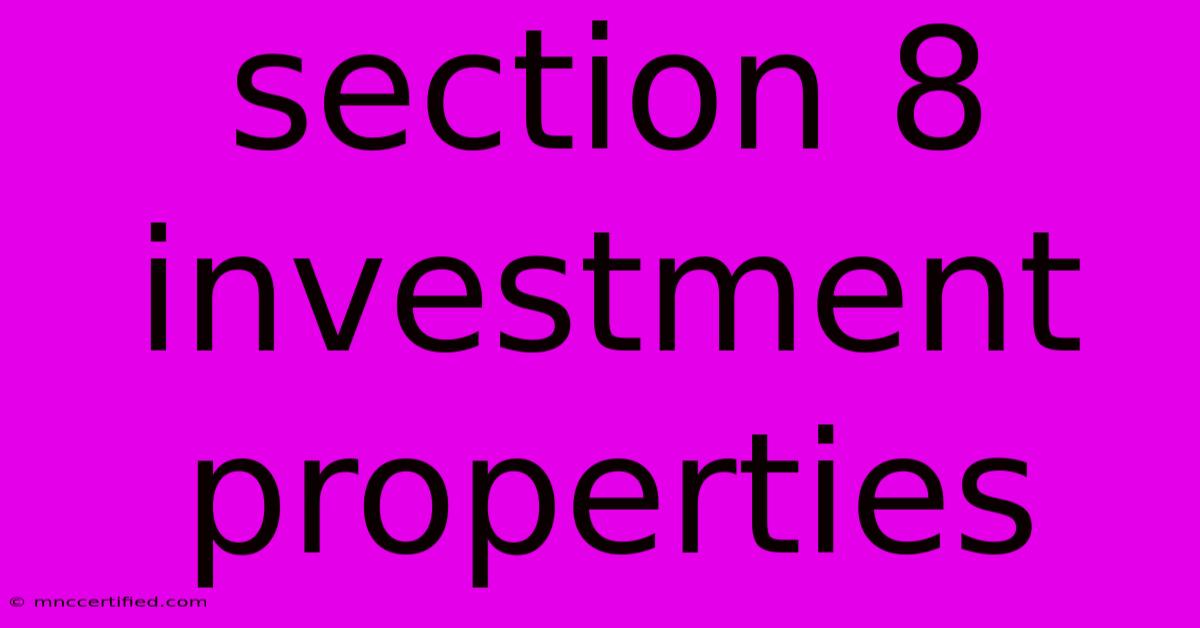Section 8 Investment Properties

Table of Contents
Section 8 Investment Properties: A Guide for Smart Investors
Investing in real estate can be lucrative, but navigating the complexities of the market requires careful planning and strategic decision-making. One avenue often overlooked by investors is Section 8 housing. This comprehensive guide will delve into the intricacies of investing in Section 8 properties, exploring the potential benefits, challenges, and crucial steps to success.
What is Section 8 Housing?
Section 8, officially known as the Housing Choice Voucher Program, is a government-sponsored program that assists low-income families, the elderly, and people with disabilities in affording decent housing. The program provides rental assistance in the form of vouchers, which tenants use to pay a portion of their rent, with the government covering the remainder. As an investor, this means guaranteed rent payments, albeit with specific requirements and regulations.
Benefits of Investing in Section 8 Properties
Investing in Section 8 properties offers several compelling advantages:
Stable Income Stream:
- Reduced Vacancy Rates: Unlike traditional rental properties, Section 8 properties boast significantly lower vacancy rates. The government's commitment to assisting tenants ensures consistent rental income.
- Predictable Cash Flow: With a guaranteed portion of the rent paid by the government, you can better predict and manage your cash flow. This predictability allows for better financial planning and reduces investment risk.
Government Support & Tenant Screening:
- Reduced Tenant Turnover: The program's stringent tenant screening process minimizes the risk of problematic tenants. This contributes to a more stable and less stressful investment.
- Financial Security: The government's backing reduces the financial burden associated with unpaid rent. While not completely eliminating risk, it significantly mitigates it.
Potential for Appreciation:
Like any real estate investment, Section 8 properties have the potential to appreciate in value over time. This provides a long-term growth opportunity beyond the consistent rental income.
Challenges of Section 8 Investing
While the benefits are numerous, it's essential to acknowledge potential drawbacks:
Strict Regulations & Requirements:
- Property Inspections: Section 8 properties are subject to regular inspections to ensure they meet certain standards of habitability and safety. Maintaining these standards requires consistent upkeep and investment.
- Administrative Hurdles: Navigating the application process, dealing with local housing authorities, and understanding program guidelines can be complex and time-consuming.
Tenant Selection Process:
- Limited Control: While the government screens tenants, you still have a say in the final selection. However, you might not have the same level of control as with traditional rentals.
- Potential for Delays: The tenant selection process can sometimes be lengthy, potentially causing delays in filling vacancies.
Lower Rental Rates:
While the guaranteed payment is beneficial, the rent you can charge might be slightly lower than market value, impacting your overall return on investment.
Steps to Investing in Section 8 Properties
Successfully investing in Section 8 properties requires meticulous planning:
-
Thorough Research: Understand the Section 8 program rules and regulations in your area. This includes familiarizing yourself with local housing authority requirements and eligibility criteria.
-
Finding the Right Property: Look for properties that meet Section 8 standards. This involves assessing the condition of the property, ensuring it adheres to local housing codes, and addressing any necessary repairs before listing.
-
Working with the Housing Authority: Establish a strong working relationship with your local Housing Authority. This ensures smooth processing of applications and facilitates communication regarding any issues.
-
Effective Tenant Management: While the government provides rent assistance, proactive tenant management remains crucial. Address repairs promptly, maintain open communication, and ensure compliance with lease agreements.
-
Financial Planning & Budgeting: Accurately estimate expenses, including maintenance, repairs, property taxes, and insurance, to ensure the investment remains profitable.
Conclusion: Weighing the Pros and Cons
Investing in Section 8 properties offers a unique opportunity to generate a stable income stream while contributing to affordable housing initiatives. While there are regulatory hurdles and challenges to navigate, the potential rewards – including predictable cash flow, lower vacancy rates, and government-backed security – make it a viable option for savvy real estate investors willing to put in the necessary time and effort. Careful planning, due diligence, and a solid understanding of the Section 8 program are paramount to maximizing your return on investment. Remember to consult with real estate professionals and financial advisors for personalized guidance tailored to your specific circumstances.

Thank you for visiting our website wich cover about Section 8 Investment Properties. We hope the information provided has been useful to you. Feel free to contact us if you have any questions or need further assistance. See you next time and dont miss to bookmark.
Featured Posts
-
Insurance For Yorkshire Terrier
Nov 26, 2024
-
New Developments In Jon Benet Ramsey Case
Nov 26, 2024
-
National Specialty Insurance Nj
Nov 26, 2024
-
Tennesse Baseball Trading Cards
Nov 26, 2024
-
Rebounder Trampoline Why Invest
Nov 26, 2024